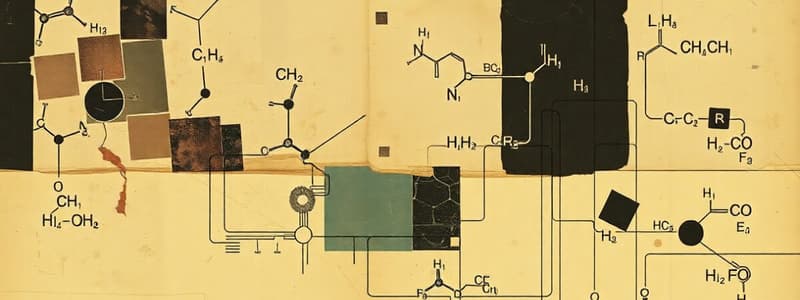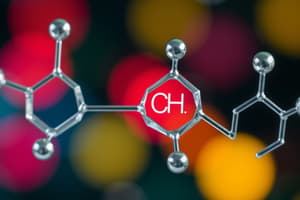Podcast
Questions and Answers
The formula for lithium carbonate is Li2CO3.
The formula for lithium carbonate is Li2CO3.
True
The maximum charge of a monoatomic anion can be determined by subtracting 8 from its group number.
The maximum charge of a monoatomic anion can be determined by subtracting 8 from its group number.
True
When naming monoatomic cations, the suffix '-ide' is added to the stem of the element.
When naming monoatomic cations, the suffix '-ide' is added to the stem of the element.
False
The oxanion of phosphorus with the highest number of oxygen atoms is named phosphide.
The oxanion of phosphorus with the highest number of oxygen atoms is named phosphide.
Signup and view all the answers
The ion fluoride carries a charge of F–.
The ion fluoride carries a charge of F–.
Signup and view all the answers
Hydrogenphosphate is represented by the formula HPO42–.
Hydrogenphosphate is represented by the formula HPO42–.
Signup and view all the answers
The nitrate ion has the chemical formula NO2–.
The nitrate ion has the chemical formula NO2–.
Signup and view all the answers
Sulfite is indicated by the chemical formula SO42–.
Sulfite is indicated by the chemical formula SO42–.
Signup and view all the answers
Hydrochloric acid corresponds to the compound represented by HCl.
Hydrochloric acid corresponds to the compound represented by HCl.
Signup and view all the answers
Ammonium is denoted by the formula NH4–.
Ammonium is denoted by the formula NH4–.
Signup and view all the answers
The empirical formula of ascorbic acid is C3H4O3.
The empirical formula of ascorbic acid is C3H4O3.
Signup and view all the answers
Dihydrogen monoxide is a chemical name for sulfuric acid.
Dihydrogen monoxide is a chemical name for sulfuric acid.
Signup and view all the answers
Vitamin C contains 54.5% oxygen in its mass percentage composition.
Vitamin C contains 54.5% oxygen in its mass percentage composition.
Signup and view all the answers
Dihydrogen monoxide can cause severe burns in its solid state.
Dihydrogen monoxide can cause severe burns in its solid state.
Signup and view all the answers
The molecular formula of Vitamin C is C6H8O6.
The molecular formula of Vitamin C is C6H8O6.
Signup and view all the answers
Nathan Zohner's experiment showed that most people were knowledgeable about dihydrogen monoxide.
Nathan Zohner's experiment showed that most people were knowledgeable about dihydrogen monoxide.
Signup and view all the answers
Cations are typically positively charged ions.
Cations are typically positively charged ions.
Signup and view all the answers
The systematic name for Na+ is sodium ion.
The systematic name for Na+ is sodium ion.
Signup and view all the answers
The major component of acid rain is actually dihydrogen monoxide.
The major component of acid rain is actually dihydrogen monoxide.
Signup and view all the answers
The characteristic charge number for Group II elements is +3.
The characteristic charge number for Group II elements is +3.
Signup and view all the answers
The Stock number is used to differentiate between ions of the same element when they have different charges.
The Stock number is used to differentiate between ions of the same element when they have different charges.
Signup and view all the answers
Mercury(I) ion has the chemical formula Hg2+.
Mercury(I) ion has the chemical formula Hg2+.
Signup and view all the answers
Cobalt(III) has an older nomenclature name of cobaltous.
Cobalt(III) has an older nomenclature name of cobaltous.
Signup and view all the answers
Group III metals always have a characteristic charge of +1.
Group III metals always have a characteristic charge of +1.
Signup and view all the answers
Fe2+ is referred to as ferrous and is also known by its systematic name iron(II).
Fe2+ is referred to as ferrous and is also known by its systematic name iron(II).
Signup and view all the answers
Tin(IV) ion corresponds to the old name stannous.
Tin(IV) ion corresponds to the old name stannous.
Signup and view all the answers
H2SO3 is named sulfuric acid.
H2SO3 is named sulfuric acid.
Signup and view all the answers
The formula for hypochlorous acid is HClO.
The formula for hypochlorous acid is HClO.
Signup and view all the answers
The oxoacid corresponding to chlorate is HClO3.
The oxoacid corresponding to chlorate is HClO3.
Signup and view all the answers
The naming of CuCl involves the inclusion of a prefix to denote the number of chloride ions.
The naming of CuCl involves the inclusion of a prefix to denote the number of chloride ions.
Signup and view all the answers
Al2O3 is commonly referred to as aluminum trioxide.
Al2O3 is commonly referred to as aluminum trioxide.
Signup and view all the answers
CaCO3 is known as calcium carbonate.
CaCO3 is known as calcium carbonate.
Signup and view all the answers
The compound MnO2 is referred to as manganese(IV) oxide.
The compound MnO2 is referred to as manganese(IV) oxide.
Signup and view all the answers
Bromic acid has the formula HBrO3.
Bromic acid has the formula HBrO3.
Signup and view all the answers
The formula Na2MoO4 corresponds to sodium dichromate.
The formula Na2MoO4 corresponds to sodium dichromate.
Signup and view all the answers
K3C6H5O7 is the formula for potassium citrate.
K3C6H5O7 is the formula for potassium citrate.
Signup and view all the answers
Study Notes
Compound
- A compound is a substance made up of atoms from two or more elements in a fixed ratio.
Empirical Formula
- Represents the simplest whole-number ratio of elements within a compound.
- Example: Vitamin C (ascorbic acid) has an empirical formula of C3H4O3. This means for every 3 carbon atoms, there are 4 hydrogen atoms and 3 oxygen atoms.
Molecular Formula
- Displays the actual number of atoms of each element present in a single molecule of the compound.
- Example: Vitamin C (ascorbic acid) has a molecular formula of C6H8O6. This means the molecule contains 6 carbon atoms, 8 hydrogen atoms, and 6 oxygen atoms.
Inorganic Chemical Nomenclature – Cations
- Metallic elements: To name a cation, add "ion" to the element name. For example, Na+ is called sodium ion.
- Group I, II, and III elements: The group number indicates the element's maximum positive charge.
- Group IV and transition metals: These elements exhibit variable charges.
- Stock number: Used to distinguish between ions of the same element with different charges. For example, Cu+ is copper(I) ion, and Cu2+ is copper(II) ion.
Cations
- Group I: Li+, Na+, K+, Rb+, Cs+
- Group II: Be2+, Mg2+, Ca2+, Sr2+, Ba2+
- Transition metals: Fe2+, Fe3+, Cu+, Cu2+, Zn2+, Ag+, Cd2+, Au+, Au3+
- Group III: Al3+, Ga3+, In+, In3+, Tl+, Tl3+
- Group IV: Sn2+, Sn4+, Pb2+, Pb4+
Ions and Ionic Compounds – Anions
- Anions: Negatively charged ions formed by gaining electrons.
- Nonmetallic elements: Characteristically form anions.
- Maximum negative charge: The maximum charge of a monoatomic anion is determined by subtracting 8 from the group number of the element.
- Naming monoatomic anions: Add " -ide" to the element's stem. For example, F- is called fluoride.
Ions and Ionic Compounds – Oxanions
- Oxanions contain oxygen and one or more other elements.
-
Names:
- Add "-ate" to the stem of the non-oxygen element's name.
- Add "-ite" for an oxanion with one less oxygen atom than its "-ate" counterpart.
Acid Nomenclature
-
Hydrogen halides:
- HCl (hydrogen chloride) in aqueous solution is called hydrochloric acid.
- HBr (hydrogen bromide) in aqueous solution is called hydrobromic acid.
-
Oxoacids:
- Replace "-ate" with "-ic acid."
- Replace "-ite" with "-ous acid".
Naming Ionic Compounds
- Order: "Cation" (followed by) "Anion" with "ion" omitted.
- Prefixes: Not used in the systematic nomenclature of ionic compounds because the cation charges determine the number of anions.
Multi-Vitamin Preparations
- Common ingredients:
- CaHPO4 (calcium hydrogen phosphate)
- CaCO3 (calcium carbonate)
- MgO (magnesium oxide)
- ZnO (zinc oxide)
- MnSO4 (manganese sulfate)
- CuSO4 (copper sulfate)
- CrCl3 (chromium(III) chloride)
- Na2MoO4 (sodium molybdate)
- KI (potassium iodide)
- Na2SeO4 (sodium selenate)
Infant Formula
- Common ingredients:
- Ca3(PO4)2 (calcium phosphate)
- K3C6H5O7 (potassium citrate)
- NaCl (sodium chloride)
- MgCl2 (magnesium chloride)
- KCl (potassium chloride)
- FeSO4 (iron (II) sulfate)
- ZnSO4 (zinc sulfate)
- CuSO4 (copper sulfate)
- KI (potassium iodide)
- KOH (potassium hydroxide)
- Na2SeO4 (sodium selenate)
Studying That Suits You
Use AI to generate personalized quizzes and flashcards to suit your learning preferences.
Related Documents
Description
This quiz covers key concepts in chemistry related to compounds, including empirical and molecular formulas. Additionally, it explores the nomenclature of inorganic cations, highlighting the naming conventions for different metallic elements. Test your knowledge on these fundamental topics in chemistry!




